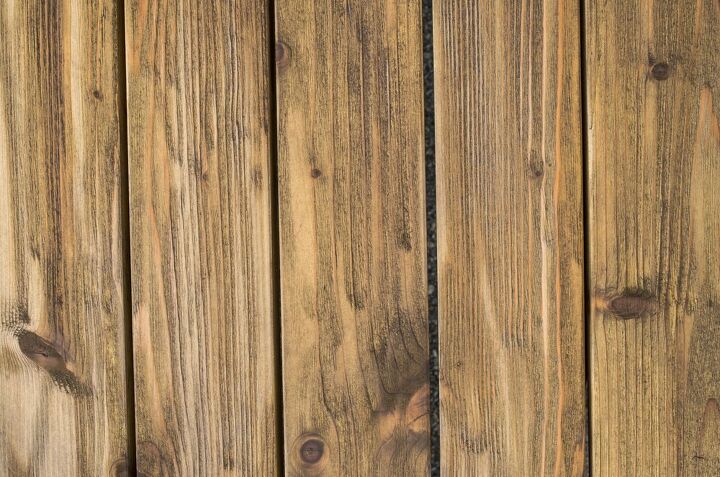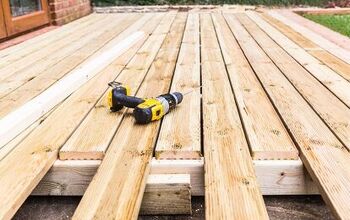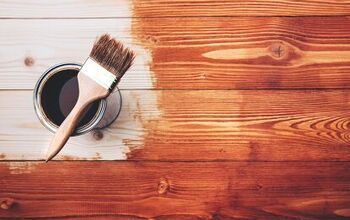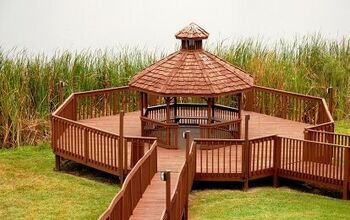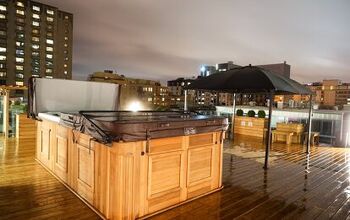Can You Build A Deck With Wet Wood? (Find Out Now!)

As you’re getting ready to build your own deck, you may come across mentions of wet wood. Whether it’s from a rainstorm the night before or the natural water content in the material, wet wood is a common problem. Can you build a deck with wet wood?
Building a deck with wet wood is not a good idea. Place the wood planks in a dry, shaded area with good ventilation. Let it dry it for a few weeks before building your deck. Use a moisture meter to check water content. Dry the wood until it has 9% to 14% moisture content.
Let’s take a closer look at what is meant by wet wood and dry wood. We will then discuss how to handle wet wood for your deck project.
Do You Need Deck, Porch, or Gazebo Installers?
Get free, zero-commitment quotes from pro contractors near you.

What is Wet Wood?
The easiest type of wet wood to recognize is when it is covered with water from a rainstorm. Wet wood also refers to the natural moisture content in the wood. Before they are cut, trees are still living and viable. They draw water into their trunks through the root system and deliver the moisture to leaves.
Wood that is cut for construction is not dead. Therefore, there is still some water remaining in the logs. Most woods contain 20% to 60% water. The amount of moisture depends on how long ago the tree was cut down. Seasoning the wood also reduces moisture content.
Much of the wood that you find at a lumber yard or home improvement store has been dried and treated. As a result, the wood has a moisture content of 20% or less.
Is Pressure Treated Wood Wet or Dry?
Pressure treated wood undergoes a process of injecting preservatives and moisture into the wood. As odd as it sounds, this actually prevents the wood from absorbing moisture. It also protects against fungus, mold, decay, and termites. The process, though, does mean that the wood is considered wet for construction purposes. It needs to sit for a few weeks to dry enough for your deck project.
What is Kiln-Dried Wood?
Kiln-dried wood has already had the moisture content reduced. The wet wood is put in a kiln, and the heat evaporates the water. Although this is a very efficient way to dry wood, it is also very expensive. If you have the budget, purchase kiln-dried lumber for your deck project.
What Happens If You Build with Wet Wood?
Building a deck with wet wood has short-term challenges and long-term consequences.
Short-Term Challenges with Wet Wood
The presence of water in the wood makes it heavier. Also, the wood it slippery. Heavy, slippery material is less than ideal when you are talking about lifting and maneuvering deck planks.
Consider that a dry plank of yellow pine weighs just under 14 pounds. The same plank when wet weighs just over 30 pounds. The additional weight comes from the 4.5 gallons of water stored in a single plank of yellow pine.
Wet wood is harder to cut, and your power tools struggle with keeping on a straight line.
Long-Term Consequences of Wet Wood for Decks
Wood is a botanical product that expands and contracts with water content. A wet deck plank is swollen with moisture. As the water evaporates, the wood fibers become more compact. Your deck planks shrink. If you build a deck with wet wood, expect gaps, warping, and other issues.
How Long Should Deck Boards Dry Before Installing?
There is a general rule for drying wood that is used for construction – 1 year for every inch of thickness. Fortunately, this does not mean that you have to wait that long to build your deck. The lumberyard dries wood before shipping it to retail stores. By the time the lumber reaches your backyard, it probably only needs 2 to 3 more weeks to dry.
Use a Moisture Meter
Home improvement and hardware stores carry handy little moisture meters. A good quality meter measures moisture content of wood to within 0.1% of the moisture content. If you are going to purchase a moisture meter, spend a little extra for a good model. Cheaper meters give you incredibly inaccurate and inconsistent results. You want the moisture content for your deck lumber to be 9% to 14%.
How to Dry Wet Wood
Drying wood is easy. It just takes some time and patience. Find a place on your property that is shaded throughout the day. It should also be away from any sources of water and ventilated. Stack the lumber with spacers between each layer, and then let nature take its course. Use a moisture meter to check the moisture content every few days.
Can You Build with Wet Treated Wood?
Treating wood adds preservatives to the wood fibers. In the process, water is also added to the wood. Building with wet treated wood presents the same issues as wet untreated wood. Namely, warping, cracking, splitting, and shrinkage are all problems that occur when you build a deck with wet treated wood.
How to Fix Problems from Wet Wood
If you’ve now realized that you should have waited for your wood to dry before building your deck, don’t panic. Let the wood dry, and see what happens. The planks may be fine. If you notice cracking, shrinkage, gaps, warping, or other problems, replace the damaged planks. You don’t have to rebuild the entire deck.
Related Questions
What is the best wood for a deck?
The best woods for decks are cedar and redwood. The woods are attractive, resistant to mold and pests, and sturdy. If you are building a deck on a budget, pressure-treated wood is the best material for your deck.
How thick should deck boards be?
Deck boards, also known as 5/4 boards, are 1” to 1 1/4” thick. Thicker 2×6 boards can also be used for decks. They measure 1.2” to 1.5” in thickness.
Do You Need Deck, Porch, or Gazebo Installers?
Get free, zero-commitment quotes from pro contractors near you.

Conclusion
You can build a deck with wet wood, but be prepared for some repairs in the near future. The best option is to be patient, and let the wood dry before building your deck. It should only take a few weeks to dry the wood.
Related Guide

Jennifer L. Eggerton loves being hands-on, whether it's with a home DIY project, making repairs, re-decorating a room, or keeping life organized. She enjoys helping people by sharing her knowledge, insights, and experiences, as well as her lessons learned. In addition to her work as a writer, Jennifer is a Jeep® overlander, self-published author, and nature photographer who loves being outdoors.
More by Jennifer Eggerton



